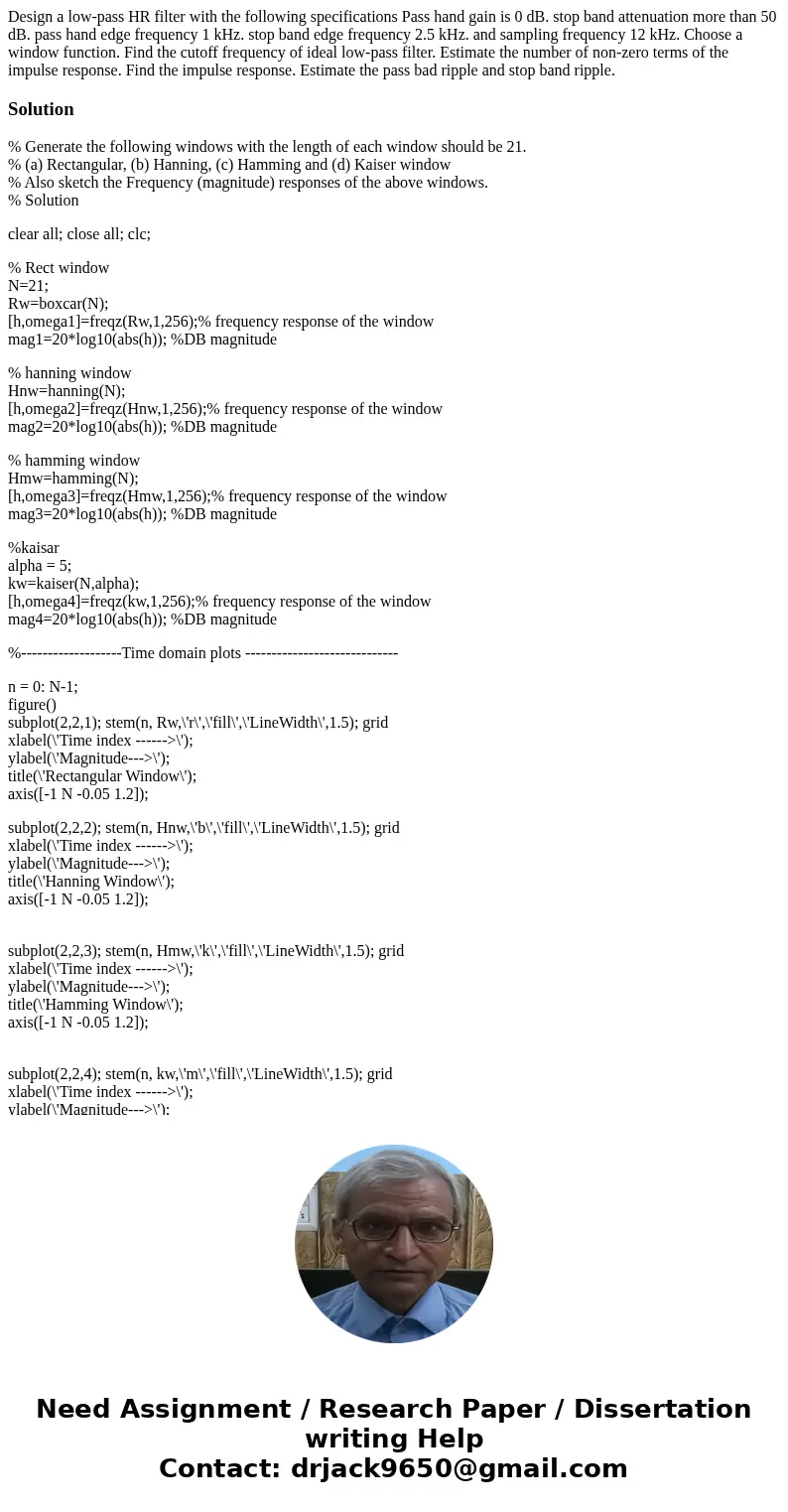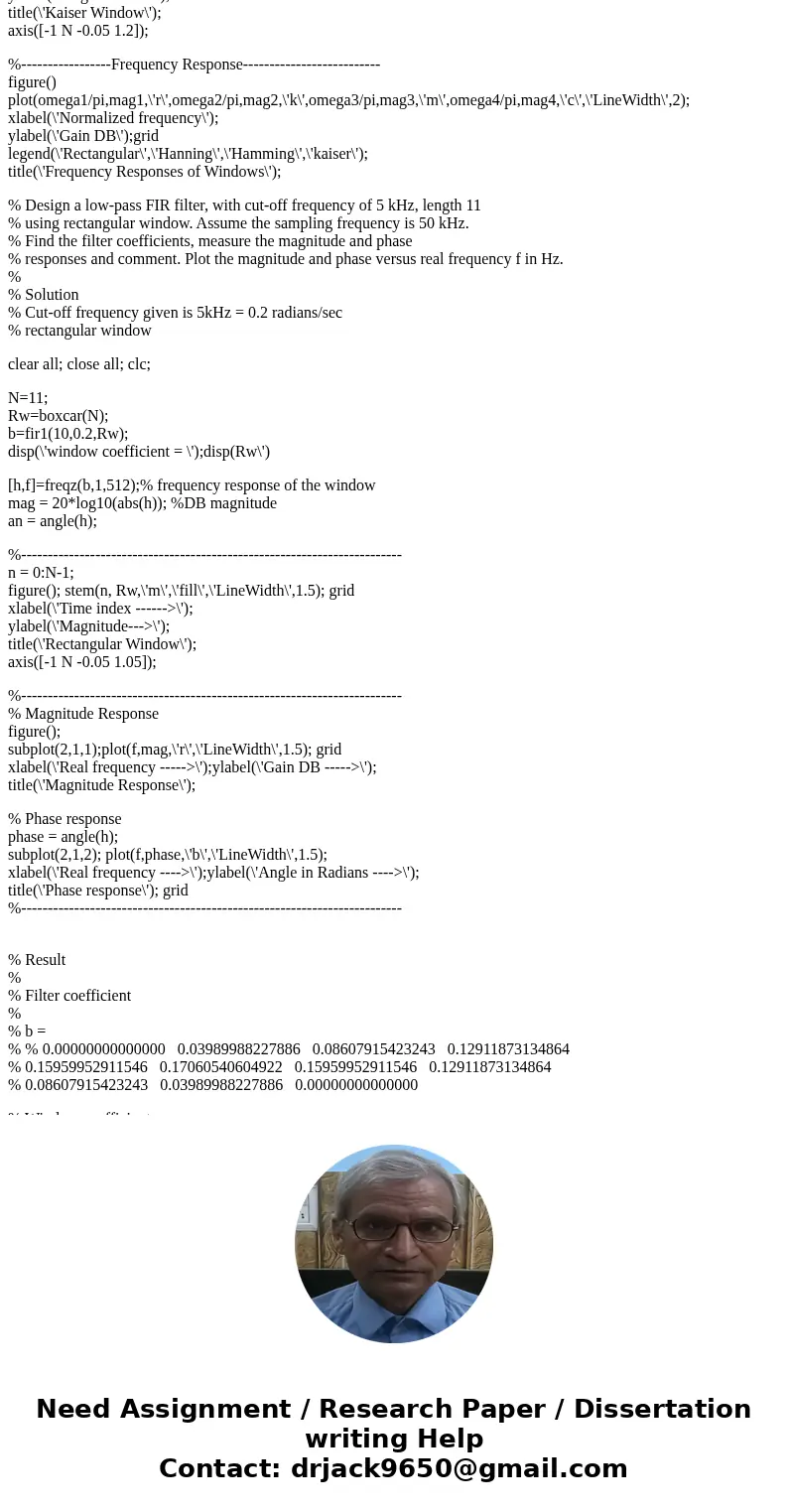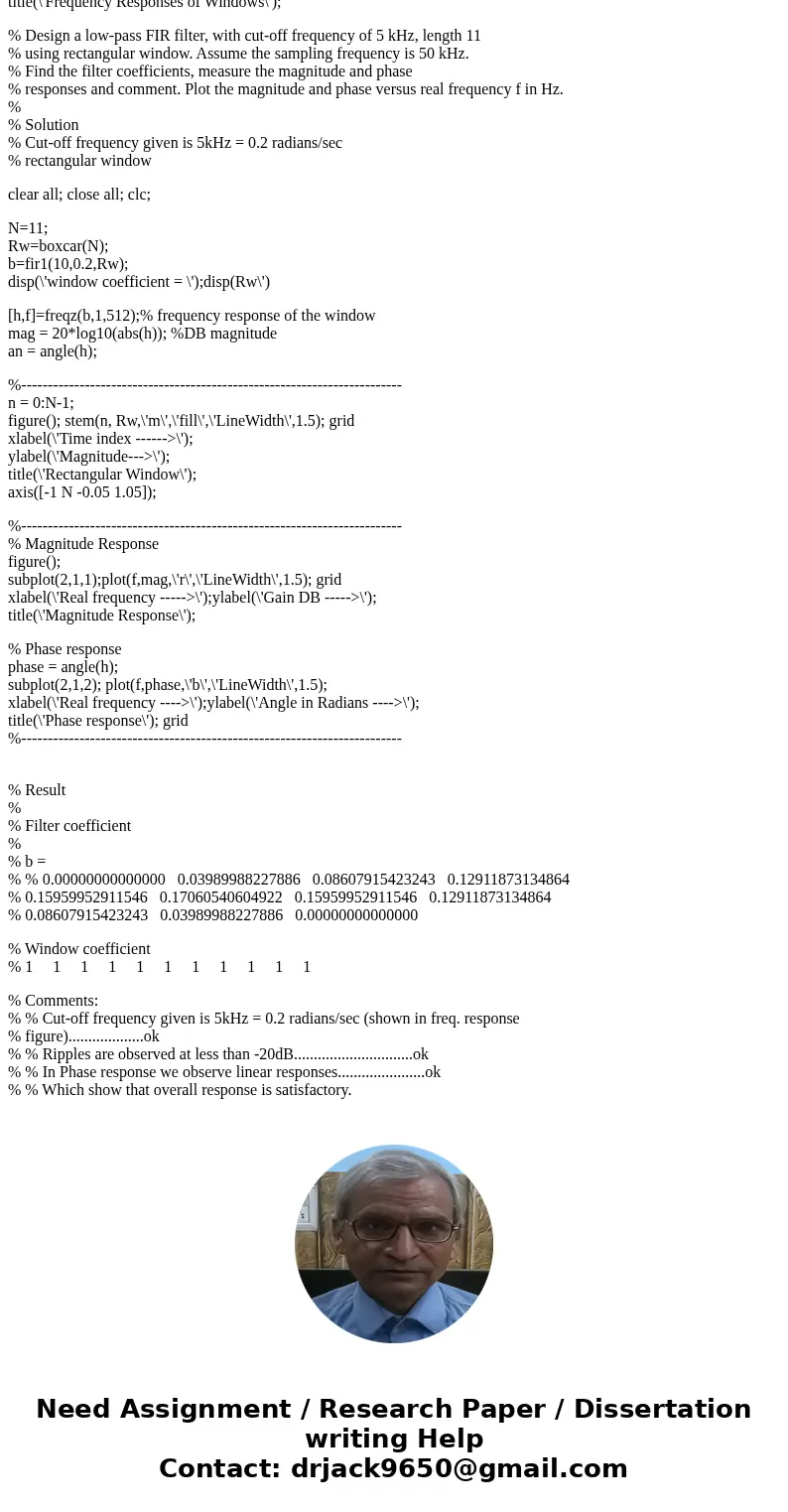Design a lowpass HR filter with the following specifications
Solution
% Generate the following windows with the length of each window should be 21.
% (a) Rectangular, (b) Hanning, (c) Hamming and (d) Kaiser window
% Also sketch the Frequency (magnitude) responses of the above windows.
% Solution
clear all; close all; clc;
% Rect window
N=21;
Rw=boxcar(N);
[h,omega1]=freqz(Rw,1,256);% frequency response of the window
mag1=20*log10(abs(h)); %DB magnitude
% hanning window
Hnw=hanning(N);
[h,omega2]=freqz(Hnw,1,256);% frequency response of the window
mag2=20*log10(abs(h)); %DB magnitude
% hamming window
Hmw=hamming(N);
[h,omega3]=freqz(Hmw,1,256);% frequency response of the window
mag3=20*log10(abs(h)); %DB magnitude
%kaisar
alpha = 5;
kw=kaiser(N,alpha);
[h,omega4]=freqz(kw,1,256);% frequency response of the window
mag4=20*log10(abs(h)); %DB magnitude
%-------------------Time domain plots -----------------------------
n = 0: N-1;
figure()
subplot(2,2,1); stem(n, Rw,\'r\',\'fill\',\'LineWidth\',1.5); grid
xlabel(\'Time index ------>\');
ylabel(\'Magnitude--->\');
title(\'Rectangular Window\');
axis([-1 N -0.05 1.2]);
subplot(2,2,2); stem(n, Hnw,\'b\',\'fill\',\'LineWidth\',1.5); grid
xlabel(\'Time index ------>\');
ylabel(\'Magnitude--->\');
title(\'Hanning Window\');
axis([-1 N -0.05 1.2]);
subplot(2,2,3); stem(n, Hmw,\'k\',\'fill\',\'LineWidth\',1.5); grid
xlabel(\'Time index ------>\');
ylabel(\'Magnitude--->\');
title(\'Hamming Window\');
axis([-1 N -0.05 1.2]);
subplot(2,2,4); stem(n, kw,\'m\',\'fill\',\'LineWidth\',1.5); grid
xlabel(\'Time index ------>\');
ylabel(\'Magnitude--->\');
title(\'Kaiser Window\');
axis([-1 N -0.05 1.2]);
%-----------------Frequency Response--------------------------
figure()
plot(omega1/pi,mag1,\'r\',omega2/pi,mag2,\'k\',omega3/pi,mag3,\'m\',omega4/pi,mag4,\'c\',\'LineWidth\',2);
xlabel(\'Normalized frequency\');
ylabel(\'Gain DB\');grid
legend(\'Rectangular\',\'Hanning\',\'Hamming\',\'kaiser\');
title(\'Frequency Responses of Windows\');
% Design a low-pass FIR filter, with cut-off frequency of 5 kHz, length 11
% using rectangular window. Assume the sampling frequency is 50 kHz.
% Find the filter coefficients, measure the magnitude and phase
% responses and comment. Plot the magnitude and phase versus real frequency f in Hz.
%
% Solution
% Cut-off frequency given is 5kHz = 0.2 radians/sec
% rectangular window
clear all; close all; clc;
N=11;
Rw=boxcar(N);
b=fir1(10,0.2,Rw);
disp(\'window coefficient = \');disp(Rw\')
[h,f]=freqz(b,1,512);% frequency response of the window
mag = 20*log10(abs(h)); %DB magnitude
an = angle(h);
%------------------------------------------------------------------------
n = 0:N-1;
figure(); stem(n, Rw,\'m\',\'fill\',\'LineWidth\',1.5); grid
xlabel(\'Time index ------>\');
ylabel(\'Magnitude--->\');
title(\'Rectangular Window\');
axis([-1 N -0.05 1.05]);
%------------------------------------------------------------------------
% Magnitude Response
figure();
subplot(2,1,1);plot(f,mag,\'r\',\'LineWidth\',1.5); grid
xlabel(\'Real frequency ----->\');ylabel(\'Gain DB ----->\');
title(\'Magnitude Response\');
% Phase response
phase = angle(h);
subplot(2,1,2); plot(f,phase,\'b\',\'LineWidth\',1.5);
xlabel(\'Real frequency ---->\');ylabel(\'Angle in Radians ---->\');
title(\'Phase response\'); grid
%------------------------------------------------------------------------
% Result
%
% Filter coefficient
%
% b =
% % 0.00000000000000 0.03989988227886 0.08607915423243 0.12911873134864
% 0.15959952911546 0.17060540604922 0.15959952911546 0.12911873134864
% 0.08607915423243 0.03989988227886 0.00000000000000
% Window coefficient
% 1 1 1 1 1 1 1 1 1 1 1
% Comments:
% % Cut-off frequency given is 5kHz = 0.2 radians/sec (shown in freq. response
% figure)...................ok
% % Ripples are observed at less than -20dB..............................ok
% % In Phase response we observe linear responses......................ok
% % Which show that overall response is satisfactory.



 Homework Sourse
Homework Sourse